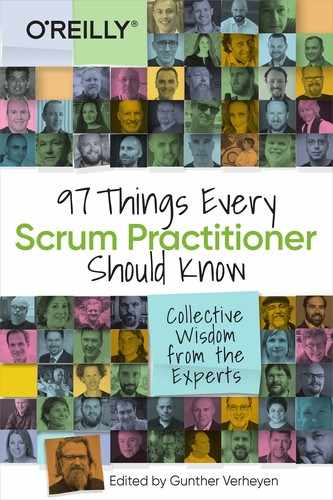Chapter 71. Use Brain Science to Make Your Scrum Events Stick
Evelien Acun-Roos

I want to share what I learned from Sharon Bowman’s “Training from the Back of the Room” class that helps me increase the liveliness of the Scrum events.
Bowman explains how the human brain processes information and what you, as a trainer or a coach, can do to enhance people’s learning and thinking experience. Bowman defines six “trumps,” based on cognitive neuroscience, to employ in order to help people learn and think better. I now also use these in conference talks, online training, and the Scrum events.
- Talking trumps listening.
Talking is a social activity. Talking improves the understanding of a subject much more than only listening. Conversing about new information helps your brain store it better. During a conversation, information is processed three times: by hearing it, processing it, and restating it. Ask people to talk to their peers or to restate something they’ve learned.
- Writing trumps reading.
Writing is a physical activity that involves both body and mind. When you write as an addition to reading, you add the sense of touch to the activity. The more senses you use, the better you learn. Help people by asking them to practice drawing, outlining, doodling, or summarizing.
- Movement trumps sitting.
When you move your body, you increase blood flow and oxygen. When your brain receives more oxygen, it gets a boost, which enhances thinking and learning. Get people’s blood flowing by standing up and walking around, or have them discuss in pairs or post sticky notes on a wall.
- Shorter trumps longer.
Our brains disconnect if nothing exciting happens for 10 minutes. If you split your content or meetings into smaller parts, you’re more likely to keep people’s attention. Change the setting and your facilitation style and set shorter time-boxes for your meetings.
- Different trumps same.
Your brain does not pay attention to boring things. To keep your topic or meeting from being boring, you can switch up and vary frequently the way you facilitate, present, or teach. Use surprising, exciting ways to get more out of a meeting or training.
- Images trump words.
Images and sounds are stored longer in your brain than words alone. Help people create mental images, metaphors, and stories.
Once you understand how these trumps work and what their benefits are, you can use them in your Scrum events. Do you recognize the trumps when doing the following in your Scrum events?
- Daily Scrum
Rotate the order of the team members’ contributions. Have the team members stand up.
- Sprint Planning
Write down the Product Backlog Items on sticky notes and put them on a physical board to visualize (draw) the business value.
- Sprint Review
Let stakeholders handle the mouse and the keyboard. Let stakeholders write or draw their feedback.
- Sprint Retrospective
Try different formats to spark creativity. Stimulate everybody to participate in the discussions.
- Sprint
Define short Sprints. Make a visualization of your definition of “Done” and put it on a wall.
I learned a lot from Sharon Bowman and her six trumps of brain-based learning. When you keep movement, vision, writing, images, brevity, and variety in mind, especially in your Scrum events, you stimulate thinking and learning, which can help you work more effectively!
